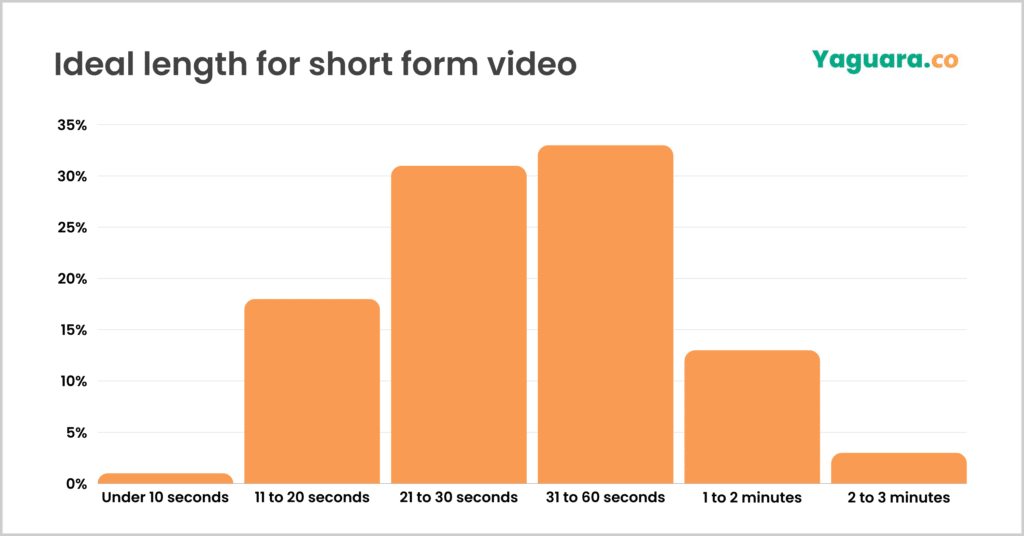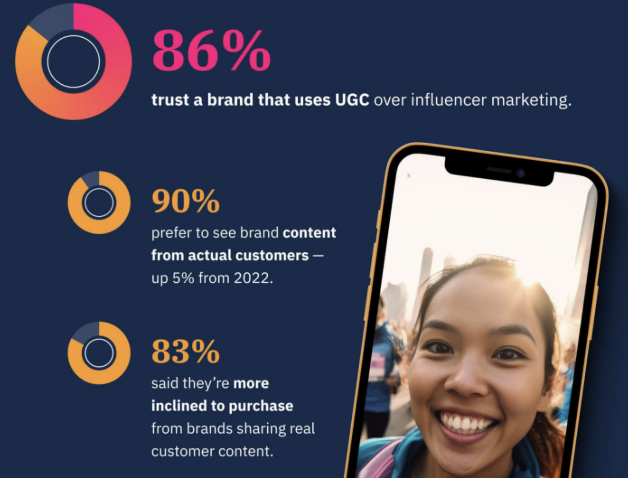
Video-first content now dominates social feeds. This is quickly moving from a trend to an industry standard.
Social media platforms have doubled down on short-form video, rewarding attention-grabbing, creator-led content over polished studio ads.
In response, marketers are shifting their budgets and creative strategies: 93% now say video delivers strong ROI, with most leaning into formats under 90 seconds to maximize engagement.
This isn’t just about keeping up, it’s about staying relevant in a scroll-first, short-attention-span world.
In this post, we’ll explore how to build a smarter video strategy, what tools are changing the game, and how to measure success in today’s fast-moving social landscape.
If you’re still running 60-second+ social media videos with a studio polish, it’s time to rethink your approach.
Today’s users scroll fast and stop only for content that feels native, personal, and immediately engaging.
The ideal length for short-form video is now between 21 and 60 seconds.

The impact of short-form video, across all platforms including TikTok, Instagram Reels, and YouTube Shorts, is growing significantly:
Brands that continue to resist these changes risk wasting budget on formats that no longer perform.
To win in 2025, you need a strategy that puts creators, data, and short-form storytelling at the center.
Here’s a quick summary of key social media video marketing strategies and best practices to keep in mind:
Together, these strategies reflect a shift toward high-engagement, mobile-focused, and deeply authentic video marketing that resonates with viewers and adapts fluidly across various platforms.
With the above in mind, let’s look at how to create a strong strategy and optimize your video content:
A strong video strategy starts with adaptability. Static, one-size-fits-all ads won’t cut it anymore, especially when platforms and audiences expect personalized, fast-paced content.
The answer? Modular creative – something that can be assembled from smaller elements and iterated as needed.
Instead of producing a single polished video, top brands start with core assets and layer in hook variations and B-rolls, allowing for fast testing and optimization.
Such a modular approach to video ads can boost engagement by up to 80% and reduce bounce rates significantly.
Equally important is the content source. User-generated content (UGC) drives 38% higher engagement, with peer-to-peer influence now playing a critical role in buying decisions.
That’s why your strategy should prioritize creators who can speak authentically to your audience, raising brand recognition and awareness.
Check out this video by Anthill for a quick explainer on the benefits of creating modular content:
To implement the modular approach, you should follow a few steps:
In 2025, your video marketing strategy needs to be both creator-first and performance-driven.
Creating “content for content’s sake” is a thing of the past, aim for modular UGC with data-backed direction.
The biggest leap in social media video marketing isn’t more content, it’s smarter content.
Platforms like Meta and TikTok are leading this shift with new formats like Partnership Ads and Spark Ads, which blend organic creator content with paid amplification.
The result? Higher CTRs and lower CPAs through native-feeling videos that are supercharged by targeted spend.
Meanwhile, algorithms are evolving fast. Social platforms now reward UGC-style content and actively penalize overt branding that disrupts the user experience.
If your video feels like an ad, it gets skipped. If it feels like a story, it gets watched, and that’s what drives results.
To stay ahead, brands are turning to tools that streamline testing, feedback, and optimization.
These tools reduce guesswork, speed up iteration cycles, and ensure your content meets both audience expectations and platform demands.
Winning tools don’t just create more content. They create the right content, fast.
When powered by insights and automation, even small teams can compete with big-budget campaigns.
Great content means nothing if it doesn’t perform. Knowing if your video is successful requires more than eyeballing likes or comments. Now it is about clear, trackable metrics.
Platforms now surface key signals like watch retention, scroll-through rate, and click-through rate (CTR).
These metrics tell you whether your content is holding attention, sparking interest, and driving action. For short-form video, retention in the first 3-6 seconds is a make-or-break moment.
Audience trust also matters: 78% of millennials and 70% of Gen Z rely on UGC when making purchase decisions.
Additionally, a recent survey by EnTribe found that 86% of respondents said they trust UGC more than influencer marketing and 90% prefer to see content from real customers.

That makes authentic, relatable videos preferred and proven performers.
And for teams using advanced tools, features like hook rate benchmarking and ROAS tracking offer even more precise feedback.
Brands with access to this data can iterate on the creative itself – tweaking intros, CTAs, or B-roll to boost performance over time.
Measuring video success in 2025 means tracking beyond vanity metrics and using those insights to constantly evolve your content.
In 2025, winning with social media video marketing means showing up smarter.
Audiences are tuned into creators, not commercials.
Platforms are optimizing for engagement, not polish. And brands that lean into short-form, modular, UGC-driven strategies are seeing the biggest payoffs.
Whether you’re scaling content or optimizing for ROAS, the right tools can turn performance from a guessing game into a repeatable process. Prioritize authenticity, test relentlessly, and let data shape your creative direction.
Dovilė Misevičiūtė is a passionate content and search marketer aiming to bring great products front and center. She is currently leading SEO at Billo, a data-driven video-ad engine. When she’s not hunched over her keyboard, you will find her in a city running a race, cycling or simply enjoying life with a book in hand.
Social media video marketing uses video content to promote a brand, product, or service on platforms like Instagram, TikTok, YouTube, and Facebook to engage audiences, build awareness, and drive conversions. Read the full guide for more on how to use video to your full advantage.
Short-form videos (under 60 seconds) grab attention quickly, are easy to consume, and perform well on platforms like TikTok, Instagram Reels, and YouTube Shorts, boosting engagement and shareability. Read the full guide for more on how successful video content is and why.
Modular creative is video content built from interchangeable segments that can be re-mixed for different platforms, audiences, or campaigns, making production faster, cheaper, and more versatile. UGC and influencer marketing content is great for use in modular creative assets as it boosts trust and credibility for your brand and provides authentic video content. Read the full guide for more on how to use video to your full advantage. Read the full guide to learn more about modular content creation for video content.
TikTok, Instagram, YouTube, Facebook, and LinkedIn are top choices, depending on your audience, content style, and campaign goals. Instagram Reels, YouTube Shorts, TikTok and Snapchat are good platforms for shortform video. Read the full guide to learn more about successful video marketing on social media.
Aim for 15–60 seconds for short-form and 1–3 minutes for long-form, tailoring length to platform norms and audience attention span. Check out the full guide for more on the ideal length for social media videos and how video length impacts engagement. Check out the full guide for more on video length and engagement rates.
Key metrics include views, watch time, engagement rate, shares, click-through rate, and conversions. Read the full guide for more on how to track and measure video performance on social media platforms, and some of the best tools to use.
Digital Agency Network: The Rise of Short-Form Video Marketing: How Brands Are Winning with Bite-Sized Content
Forbes: Short-Form Video Content: Capturing Attention In The Digital Age
HubSpot: Marketing Statistics Every Team Needs to Grow in 2025